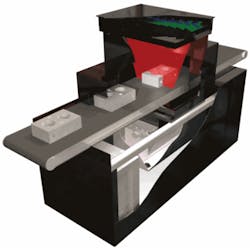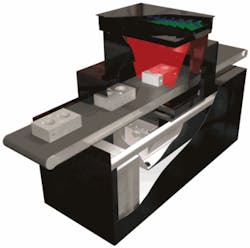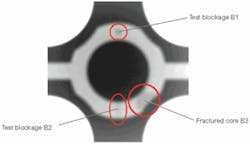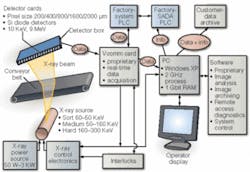Modular system inspects automotive parts
A combination of sources, detectors, and electronics provide custom in-line inspection capability.
By Jan Zandhuis
The use of automated x-ray inspection systems has grown in many industries. X-ray radiation can penetrate materials, enabling inspection systems that can image and measure hidden features. For example, the pharmaceutical industry uses x-ray imaging to count pills in blister packs and ensure that literature is included in the box. The automotive industry also uses this technology as part of a growing need for six-sigma quality assurance and product traceability to limit liability and improve product quality. Many times, a single x-ray scan can reduce the need for visible inspection stations because it can perform a final quality check after packaging, rather than at key nodes along the production line.
Recently, 3DX-Ray Limited, a subsidiary of Image Scan Holdings, developed an automated inspection system for a German automotive manufacturer. The system can measure cooling channels buried in automotive cylinder heads to within a tolerance of 0.5 to 1 mm. 3DX-Ray developed the x-ray system based on its X-LINE modular x-ray imaging platform, which provides high throughput and spatial resolution through a proprietary matrix of silicon diode detectors and a medium-power x-ray source (160 keV) that can penetrate approximately 9 cm of aluminum and still have sufficient contrast to allow image processing algorithms to clearly detect and measure the cooling channels within the x-ray shadowgraph. Using proprietary electronics interfaced to a networked PC, the in-line system provides sufficient resolution, security, and speed to overcome traditional x-ray inspection hurdles of cost, throughput, and safety (see Fig. 1).
Modular X-Ray
3DX-Ray developed the X-LINE family of x-ray imaging components-including x-ray sources, customizable silicon diode linear and matrix array detectors, power source, control electronics, and VComm frame grabber and I/O board-to serve x-ray imaging applications that range from large container security inspection to small electronics inspection. Most x-ray systems are too slow to be in-line. The combination of sources, detectors, and electronics allows the company to tailor the system to the customer’s needs and performance requirements.
A cylinder-head inspection application requires the inspection system to detect cooling channels several millimeters in width located 9 cm below the surface of a cast-aluminum engine cylinder head and verify the dimensions of the channels in three dimensions to within 0.5 to 1 mm. This in-line inspection application requires the X-LINE system to acquire 3-D x-ray shadowgraphs-created by combining transmitted and scattered x-rays-within a 10-s inspection window to keep up with the production line throughput (see Fig. 2).
In operation, a conveyor carries the engine cylinder heads through the X-LINE inspection chamber, which is custom made for each application. The x-ray source is opposite an array of 100-μm silicon diode detectors. As the cylinder head reaches the inspection zone inside a shielded enclosure, position data from an optical encoder attached to the conveyor keys the PLC controlling the conveyor to halt the material handling system for a 10-s inspection window.
The external PLC triggers the X-LINE inspection system through one of 16 optoisolated LVDS I/O connectors on the VComm frame-grabber card located inside the X-LINE enclosure. The x-rays pass from the x-ray tube source through the cylinder head and strike a phosphorous scintillator. Since direct exposure to x-rays would degrade the silicon, the scintillator produces visible light that is detected by the silicon diodes.
The cylinder head was designed with an area array to improve the system’s throughput. Linear arrays can reduce the cost of x-ray inspection systems by 50% or more, but these systems often require higher-power x-ray sources and take more time to acquire a full image because the object must be moved through the x-ray field. An area array can capture an image with a single x-ray exposure, improving throughput.
Multichannel Electronics
The analog signals from the area array are passed along multiple readout channels integrated into the X-LINE detector design to 3DX-Ray’s VComm frame grabber, which uses multiple A/D converters and buffer memory to convert analog signals at rates greater than the 1.5-Mbytes/s USB 2.0 output. The company produces its own x-ray detectors so that it can control readout speeds by increasing the number of readout channels, adjust the spatial resolutions based on diode sizes ranging from 200 to 2000 μm, and control costs and throughput based on linear or area array configurations. Also, every X-LINE system uses the VComm card, adding to the modularity of the design and easing spare part inventories and 3DX-Ray’s long-term support.
The VComm’s USB 2.0 output is the communication channel to an external PC, which stores the x-ray images and measurement data for later retrieval by the plant LAN. The PC runs Windows XP on a 2-GHz microprocessor with 1 Gbyte of RAM, standard video card, high-capacity internal hard drive, and 10/100 Ethernet capability. The PC also contains X-LINE modular software, based on C++, that assimilates the data from each detector into a 3-D image, locates the cooling channels in the image, and measures the size of each channel along its full length. While standard output from the X-LINE software is to a SQL-based database, the interface can be cutomized to match any storage or statistical analysis program the end user specifies (see Fig. 3).
Image processing with x-rays is far more dependent on the actual physics of the situation. X-ray images are shadowgraphs and tend to be more poorly defined than their visual counterparts. For example, edges are not usually distinct, contrast is lower, and the overall image is subject to increased noise. For these reasons, 3DX-Ray relies on its own image-processing algorithms, including areas such as edge detection, linear measurement, and volume estimation. The images for the cylinder-head inspection show the absorption, noise, and scatter issues of a freshly cast standard aluminum cylinder with water. From this, automatic, high-speed measurements for linear distances and volume can be produced. The volume measurement of channel size is a far more robust than simply knowing the width and height.
In addition to receiving output from the detectors and master PLC and sending data to PC storage, the VComm card uses its additional 15 I/O ports to communicate with interlock sensors located at enclosure access points. To shield the customer from the x-rays, but provide access to the system, every door that allows access to the inspection chamber has a security switch or interlock, which can be magnetic, capacitive, or mechanical. Safety and functionality of the system is also provided.
Image data, measurement data, and alarms are displayed on a monitor attached to the PC. In addition to storing the inspection data, the PC attached to the plant LAN can be used as a gateway to remotely access and diagnose the X-LINE system. The modular design of the X-LINE system allows 3DX-Ray to make detectors up to 5 m long for security and cargo inspection and support x-ray sources from 50 to 160 keV and beyond.
Jan Zandhuis manages the industrial applications sector at 3DX-Ray Limited, Melton Mowbray, UK; www.3dx-ray.com.



